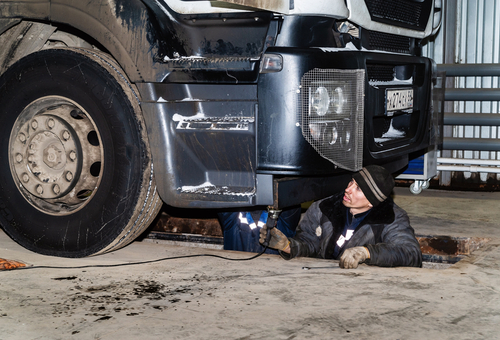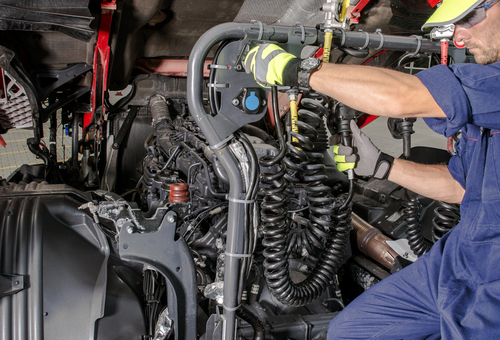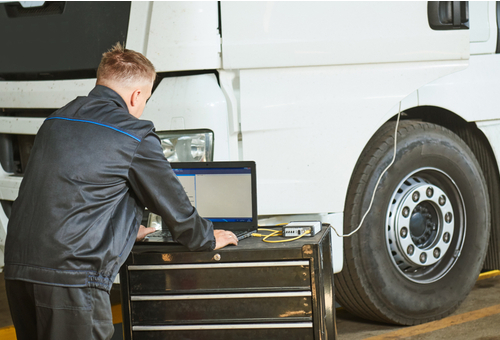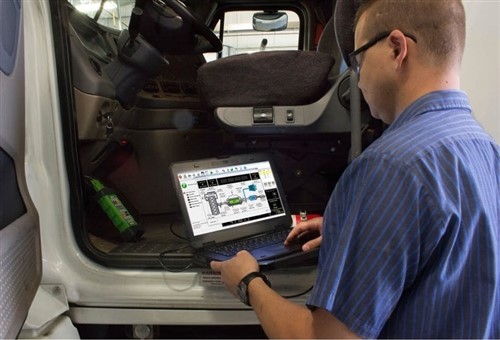
Even though both the country’s larger economy and the many people living in remote communities depend on truck mechanics to keep the national fleet of heavy trucks of all classes on the road, the fact is that many of us simply don’t love trucks enough to want to repair them as a way to earn a living. We are, however, not suggesting that taking up truck repair is a bad career choice, or that truck mechanics are somehow inferior to car mechanics: far from it.
However, from a car mechanic’s perspective, the fact is that (almost) everything on trucks is big and heavy, which often makes truck repairs not only very hard work but also difficult and expensive in terms of the cost of the oversize tools required to be an effective truck mechanic.
Given the above, many of us can be forgiven for having chosen not to enter the truck maintenance industry, but the other side of the coin is that modern heavy trucks are not only several orders of magnitude more advanced than even their immediate predecessors were; they are also becoming a whole lot easier to diagnose and repair. Thus, in this article, we take a closer look at some of the technological advances in modern heavy trucks, as well as at some of the steps that both tool and truck manufacturers are continuously introducing to make diagnosing and repairing modern trucks a whole lot easier.
NOTE: While some of the information in this article might come across as preaching to the converted, i.e., experienced truck mechanics, all of what follows is aimed not only at inexperienced truck mechanics but also at mechanics from other fields that may be considering moving into the heavy truck repair industry. As such, the information provided here is intended to be of a general informational nature, and is therefore neither complete nor exhaustive, meaning that nothing in this article should be construed as encouragement to leave your current job to move into the truck repair industry-which could well be a bad career move on your part. Before we get to the specifics, though, let us start by stating some-

Image source: https://www.fleetequipmentmag.com/advanced-truck-driver-assistance-systems/
Although this article is more about the day-to-day slog of keeping a truck running than it is about finding and fixing exotic issues like multiple CAN failures, this article would not be complete without at least some discussion of the advanced ADAS systems that are becoming the norm on modern trucks. ADAS systems, such as, for instance, emergency braking systems that can bring an 18-wheeler loaded to its maximum allowable weight, and travelling at 80 km/h, to a full stop in less than 3 seconds without crashing or jack-knifing.
We can all agree that this is remarkable. Remarkable not only because a human driver can't emulate this kind of braking performance without crashing, but also because the emergency braking systems on most modern heavy trucks can initiate emergency braking events autonomously while at the same time, taking active control of the steering system to prevent a panicked driver from making ill-judged steering inputs.
While forward accident mitigation technologies are arguably the most effective ADAS systems in current use on heavy trucks, three other systems that are currently available largely prevent potentially dangerous situations from developing in the first place. The three most important such systems include the following-
Active Speed Intervention
Although this sounds a lot like cruise control, Active Speed Intervention systems “read” and recognize speed limit signs, and when a truck exceeds the posted speed limit, the system will issue both audible and visible alarms. However, depending on how far the truck exceeds the speed limit, the system will effectively cut the engine power for two seconds as a warning to the driver to reduce speed. If the driver does not react to thre warning, the system will either reset the cruise control system to meet the speed limit, or it may deactivate the cruise control system altogether.
Lane Keep Assist
Lane Keep Assist systems come in several “flavours”, the various flavours depending on both the truck manufacturer, and the options that are available in a particualr model range. Nonetheless, most Lane Keep Assist systems use a variety of cameras, microphones, radar and/or lidar transponders, and one or more control modules, some of which can assume control over the steering system either to keep a truck centred in a driving lane or to force it back into a driving lane.
However, one major development is the Lane Keep Assist (LKA) with Auto Stop, which is available on new Freightliner Cascadia models. This system takes Lane Keep Assist systems to a completely new level because it does the following-
Apart from keeping the truck centred in a driving lane, it can detect when a driver becomes incapacitated (or removes his hands from the steering wheel) for more than 60 consecutive seconds. When this happens, the system will activate the brakes to bring the truck to a full stop while maintaining its position in the driving lane. Moreover, when the truck comes to a stop, the doors unlock automatically, and the interior lights begin to flash in an SOS pattern to alert other drivers that assistance is required.
Brake Hold Mode
While this system is largely analogous to Hill Start Assist systems commonly found on many light vehicles, this system can cold a truck stationary in any attitude. Here is how it works-
When a truck comes to a full stop, regardless of whether it is positioned on a level surface, an inline, or a decline, the driver presses the brake pedal once more to activate the system, removing the need for the driver to hold the brake pedal continually to keep the truck stationary for long periods. Thus, the brakes will remain engaged even if the driver removes his foot from the brake pedal. To deactivate the system, the driver needs to press the brake pedal one time, or press down on the accelerator pedal.
In both cases, one or more control modules use input data from the wheel speed sensors (and others) to synchronize the release of the brakes with the application of power to prevent the vehicle from rolling backwards on an incline, or forwards on a decline.
We can list many other examples of ADAS systems on heavy trucks, as well as provide details on other systems that are now under development, but that would fall outside the scope of this article. Moreover, the above discussion does not answer the question of how these systems make truck maintenance easier, since these systems greatly increase a modern truck’s complexity, which brings us to-

Despite their size and weight, heavy trucks suffer relatively few mechanical breakdowns if they are maintained per their specified service/maintenance schedules. In fact, keeping a well-maintained truck in a good condition rarely involves more than routine checks, inspections, and servicing. Thus, for the most part, the daily grind of truck maintenance largely involves finding and repairing air/vacuum leaks, inspecting and adjusting brakes and wheel bearings, and changing fluids and filters.
However, the rapidly increasing complexity of the electrical/electronic systems on modern heavy trucks means that electrical issues account for the vast majority of breakdowns and resultant downtime. There are several reasons for this, not the least of which is the fact that large sections of a truck’s wiring are directly exposed to the elements.
This is not such a serious problem in the American and European markets where few trucks ever see an unpaved road, but in the local market, many trucks spend the biggest part of their lives on dirt and gravel roads. In short, much of the electrical systems of Australian trucks are directly exposed to high ambient temperatures and severe vibrations, while being immersed in dense clouds of dust and sand, at the same time.
Moreover, no truck manufacturer has ever been able to design electrical connectors, wiring terminations, or enclosures for fuse boxes and control modules that are immune to the effects of severe vibration and the presence of dust and moisture when all three are present at the same time. Thus, the high-frequency vibrations that are present in trailers destroy electrical connectors, weather/dust seals, as well as wiring terminations, while the ingress of dust and sand past damaged seals grind away terminals and pins in connectors.
In the interest of fairness, though, it must be said that truck manufacturers are continually developing new cable/wiring connectors and electrical enclosures, and most fleets and truck owners install these revised parts as soon as they become available. Nonetheless, just as on light vehicles, the ADAS systems on modern trucks depend on the integrity of all electrical connections for all installed systems to work as their designers intended. Nonetheless, given that many modern trucks have more than 100 sensors and up to two dozen control modules, where do you begin to look for a bad connection, corroded connector, or frayed wire?
All truck mechanics will tell you that this is not always easy. All truck mechanics will also tell you that you can spend an entire day unpicking the wiring on a trailer to look for the cause of dead taillights and not find the fault- only for the fault to reappear when the trailer is being towed. Under real-world operating conditions, the high-frequency vibrations on well-used trailers can, and do, induce many electrical faults that are impossible to diagnose when such a trailer is stationary (and therefore, not vibrating) which begs the question of how any of this makes repairing trucks any easier?
Well, it doesn’t, but it so happens that in recent years, truck manufacturers have begun to realise that the combination of the increasing complexity of modern trucks and the extreme length of wiring harnesses is making it increasingly difficult to find and resolve electrical issues on trucks and trailers.
Note that the increasing difficulty of fixing electrical issues on modern trucks does not only apply to ADAS, lights, and braking systems; it also applies to engine management, transmission control, effective fuel delivery (that depends on calibrated injectors), and exhaust after-treatment systems, which if anything, are somewhat more complex and temperamental than the analogous systems on light vehicles are.
In addition, since a truck that is not hauling freight because it is being worked on costs its owner(s) a lot of money, the manufacturers of both trucks and diagnostic equipment have formed close working relationships to jointly develop-

While both truck-specific scan tools and diagnostic software have been available for a while, those of us who don’t work on heavy trucks every day could be forgiven for thinking that the capabilities of these tools and software programs have kept pace with those in use on light vehicles.
The fact is that it was not so much a question of truck-specific diagnostic equipment lagging behind equipment for light vehicles, as it was a question of trucks largely not requiring advanced equipment since until comparatively recently, heavy trucks were relatively uncomplicated and most had few (if any) electronically controlled parts and/or systems. As a matter of fact, the scan tools used on trucks as recently as fifteen years ago were designed primarily to read some basic engine function and emissions trouble codes, most of which were related to issues that prevented trucks from passing compulsory emissions checks in the American and some European markets.
Now, however, heavy trucks are in the opening stages of a revolution in electronic control, monitoring, and management systems that necessitates the use of advanced equipment that can not only scan all electronically controlled parts and systems but can also test and verify the operability (or otherwise) of all systems through fully integrated bi-directional controls. Moreover, modern truck scan tools are also required to have the functionality to test, scan, and calibrate ADAS systems.
The above is saying a lot in one go, so let us take a closer look at some of the aspects of diagnostic test equipment that today’s truck mechanics rely on to be effective at their jobs-
The biggest difference between the telematics systems on passenger vehicles that allow occupants to make doctors’ appointments and organize their daily schedules, and those on heavy trucks is that the telematics systems on modern trucks are primarily designed to detect electrical/electronic failures and malfunctions. This data is then transmitted to fleet managers, service providers, and the truck’s manufacturer, all of whom use advanced diagnostic equipment to decode and interpret the data in real time.
One further development involves so-called "smart trailer" systems that can alert drivers and/or fleet managers of impending failures in various electrical systems associated with the trailer. For instance, a smart trailer can predict impending electrical failures based on stored historical data, such as, for instance, the frequency of light bulb failures and other electrical parameters, such as repeated intermittent loss of continuity in wiring.
Moreover, smart trailers can also monitor wheel hub temperatures, and alert both the driver and relevant service providers of the fact that one or more hubs and/or brake assemblies require servicing before tyre or wheel bearing failures can potentially occur as a result of an excessive hub or brake temperature.
Overall, the single biggest advantage of smart telematics systems is that they reduce downtime by sending fault codes and other operational data to fleet managers and service providers in real time, meaning that in many cases, it is possible to detect (and repair) faults, failures, and defects in a wide range of systems even before trucks leave their home base. Moreover, in many cases, such faults and/or defects may have existed without drivers and/or mechanics being aware of them.

Electrical diagnosis has always been one of the biggest pain points in truck repair- not because electrical systems on trucks are inherently more complex than on light vehicles, but because different parts of the wiring harnesses could be in use- even though the basic harnesses are the same in all examples of a certain truck model range.
So, depending on the options chosen by the operator, any given truck could have a multitude of “blank” wires, while any other given truck could have different "blank" wires because the two trucks are spec'ed differently. We see this on light vehicles as well but the problem with heavy truck wiring is that the two ends of some circuits could not only be tens of metres apart: there could also be several electrical consumers, protection devices, connectors, and slip joints present between the two ends.
This made tracing wires difficult even before the ADAS revolution, which greatly added to the complexity f truck wiring, but several scan tool manufacturers now offer tools that feature interactive wiring diagrams. This feature is not exactly new, but the latest iterations of active wiring diagrams allow a scan tool user to identify a wire in a truck's harness based on its colour-coding, diameter, and/or position in a connector.
This means that if a driver reports a fault like say, an intermittently working instrument or gauge on the dashboard but the problem cannot be replicated in the workshop, it is possible to display the relevant section of the wiring diagram on the scan tool. In most cases, “clicking” on an implicated wire on the scan tool will highlight that wire, and by using dedicated controls, the user can trace that wire through every consumer, sensor, control module, actuator, gauge, protection device, slip joint, or control device it either passes through or connects to.
Moreover, the scan tool will provide descriptions of the locations of every component the wire passes through, as well as some guided tests to check the operation of affected/implicated consumers/devices/components. In addition, the scan tool will also list the voltages and/or currents an implicated control module expects to see at all critical points in the circuit, as well as information on allowable deviations from expected values.
So, in practice, such a scan tool removes not only the drudgery of tracing wires manually; it also removes all the guesswork that often forms the basis of tricky electrical diagnostic procedures. We in the light vehicle repair industry should be so lucky, but then again, the harnesses we work on are smaller and much more compact than those on heavy trucks, so there is that.
Apart from ADAS systems that may require recalibration after some service and/or repair procedures, two other systems on modern heavy trucks are critically important and may require relatively frequent calibration to ensure the engine operates at its peak at all times. Here are some details-
SCR exhaust after treatment
SCR or Selective Catalytic Reduction technology uses a liquid reductant, also known as AdBlue, or DEF to render some of the most toxic components of diesel exhaust harmless, and for the most part, this system on heavy trucks works in the same way as the SCR systems we see on light vehicles. The only real difference is that SCR systems on heavy trucks are bigger than those we know, and they process larger volumes of exhaust gas than we are used to seeing on light vehicles.
However, due to the way most heavy trucks are built, some of the sensors associated with the DEF injection system are exposed to the elements, and one particular sensor, known as the QLS (DEF Quality Level Sensor) sensor is particularly prone to failure. Just as on light vehicles, the failure of this sensor will set fault codes and may cause the truck’s engine to suffer progressively more severe power derates- until eventually, the truck will enter a no-start condition.
Assuming that the DEF fluid is not actually contaminated, the only way to resolve a power derate or a DEF-related no-start condition is to replace the faulty sensor, and then to perform a major recalibration of the DEF injection system to let the engine control module know that the fault had been repaired.
We do much the same thing on light vehicles on occasion, but if you are a heavy truck mechanic, you'll be glad you have a high-end scan tool available to fine-tune the SCR system because in many cases, the only other remedy is replacing the entire DEF injection system, which could take a full day of work.
Variable Geometry turbochargers
The difference between VGT turbos on light vehicles and those on heavy-duty truck engines is that the vanes on these turbos on small engines rotate into, and out of the exhaust stream, while on heavy-duty engines, the vanes are either retracted into the casing or extended outward from the casing into the exhaust stream along the axis of the turbocharger’s shaft. In practice, VGT turbochargers on heavy trucks are controlled by microprocessors via hydraulic or vacuum-assisted actuators, while in some cases, the turbocharger is controlled by brake system pressure.
Moreover, VGT turbos on many trucks are also used to initiate or control EGR flow by increasing the pressure in the exhaust manifold until it exceeds the pressure in the intake manifold to assist in reducing the formation of NOx during gearshifts or other transient events of short duration. On some truck engines, VGT turbos also act as exhaust brakes, as well as the mechanism that raises the exhaust gas temperature to initiate DPF regeneration events.
We need not delve into the specifics of how all of this is achieved, but suffice to say that the correct functioning of the VGT turbo plays a critical role in the efficient management of the engine. So if you are a heavy truck mechanic and have to diagnose issues like-
- and/or DPF failures on an engine that is as big as some small cars, you’ll be glad that you have a high-end scan tool available that can either confirm or eliminate poor VGT turbocharger calibration as the principal cause of these (and other) drivability and/or performance issues, which leaves us with this-
Although many diagnostic and repair procedures on heavy trucks have become a lot easier in recent years, it would be a mistake to think that fixing trucks for a living has become like the proverbial walk in the park. It is most definitely not; truck repairs remain hard, challenging work that becomes even more so when you have to perform repairs at the roadside.
Nonetheless, the advent of highly specialized, albeit very expensive diagnostic equipment has removed much, if not all of the drudgery and guesswork from truck repairs, meaning that any reasonably competent diesel mechanic with experience on modern light vehicles should be able to diagnose and repair most run-of-the-mill kinds of issues on most modern heavy trucks.
However, just because you feel you could do something does not mean you should do it, but then again, if you feel that you are ready to take on new challenges, we hope that the information provided in this article will help you make the right decisions in taking your career to new heights.